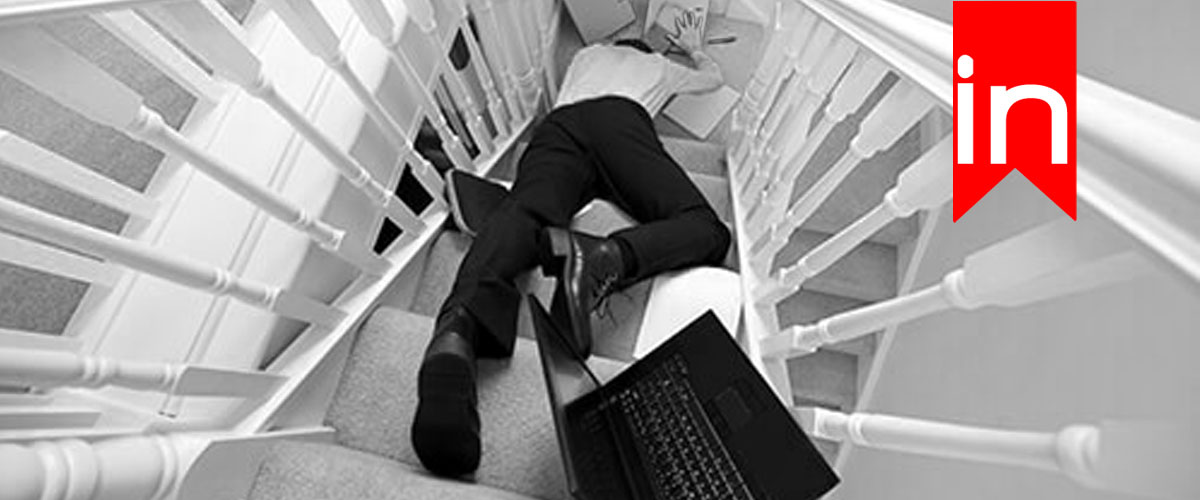Falling down the stairs can be an alarming experience, and it can happen to anyone, regardless of age or physical condition. The consequences of falling down the stairs can range from minor bruises and sprains to more severe injuries requiring emergency medical attention or long-term therapy. Public Health Agency of Canada, falls are the leading cause of injury among Canadians aged 65 years and older, and falls down stairs are one of the most common causes of falls. It is important to take steps to prevent falls down stairs and reduce the risk of injury.
While it can be a scary experience, there are steps that can be taken to minimize the risk of injury. Simple measures, such as ensuring that the stairs are well-lit, free of clutter, and have a secure handrail, can help prevent falls. Additionally, taking one’s time and being mindful of one’s surroundings when ascending or descending the stairs can go a long way in preventing accidents.
It’s important to note that certain groups may be more susceptible to falling down the stairs, such as older adults or individuals with mobility issues. However, with awareness and precaution, the risk can be significantly reduced. In this article, we will explore the common causes of the types of injuries that can result, and practical tips for preventing falls.
Causes
Stair falls can happen to anyone at any age, but it is more common among older adults. According to the CDC, falls are the leading cause of injury and death among older Americans. There are several factors that can contribute to falling down the stairs, including physical, environmental, and behavioral factors.
Physical Factors
Physical factors that can increase the risk of falling down the stairs include vision problems, muscle weakness, balance issues, and medical conditions such as Parkinson’s disease, arthritis, and stroke. Age-related changes in vision, hearing, and balance can also make it more difficult to navigate stairs safely.
Environmental Factors
Environmental factors that can contribute to stair falls include poor lighting, cluttered stairs, loose or broken handrails, and slippery surfaces. Stairs that are too steep or have uneven steps can also increase the risk of falling. In addition, wearing shoes with poor traction or loose clothing that can get caught on the stairs can also be a hazard.
Behavioral Factors
Behavioral factors that can increase the risk of falling down the stairs include rushing, being distracted, carrying heavy objects, and not using handrails. Alcohol consumption and certain medications can also affect balance and increase the risk of falling. In addition, fatigue and lack of sleep can impair judgment and reaction time, making it more difficult to navigate stairs safely.
Possible Injuries Sustained
When someone falls down the stairs, injuries can range from minor to severe. In some cases, it can cause a traumatic brain injury or even be fatal. This section will discuss the common and serious injuries that can occur as a result of falling down the stairs.
Common Injuries
The Canadian Institute for Health Information (CIHI) reports that falls are a leading cause of injury-related hospitalizations and emergency department visits in Canada. CIHI data shows that falls down stairs are one of the most common causes of falls resulting in hospitalization, and that the most common injuries resulting from falling down the stairs include:
- Broken bones, particularly in the ankles or wrists when an individual tries to break their fall
- Cuts and bruises, soft tissue injuries
- Head and/or neck injuries, which comprised 21.6% of total injuries in one study
- Internal bleeding
- TBIs or traumatic brain injuries, including concussions
In addition to physical injuries, these types of falls can also have psychological effects. Individuals who have fallen down the stairs may experience anxiety or fear related to using stairs in the future.
Serious Injuries
While some injuries resulting from falls down the stairs may be relatively minor, other injuries can be much more serious and require medical attention. For example, Canadian Institute for Health Information (CIHI), that head, neck, and spinal cord injuries can be particularly severe. Also it is a possibility that a traumatic brain injury may occur. These types of injuries can result in long-term disability, chronic pain, traumatic brain injuries, and other complications. Among older adults hospitalized due to falls down stairs, the most common types of injuries were fractures (59%), followed by head injuries (21%) and injuries to the trunk (11%). The average length of stay in the hospital for older adults hospitalized due to falls down stairs was 12.4 days.
If someone falls down the stairs and experiences any of these symptoms, they should seek medical attention immediately:
- Loss of consciousness or decreased level of consciousness
- Seizures or convulsions
- Severe headache or head pain that does not go away
- Dizziness or vertigo that lasts for more than a few minutes
- Blurred vision or double vision
- Nausea or vomiting that is persistent
- Slurred speech or difficulty speaking
- Weakness or numbness in any part of the body
- Difficulty breathing or shortness of breath
- Bleeding from the head, nose or ears
Stair Falls Are Preventable
Falls down stairs can result in serious injuries, so it’s important to take steps to reduce the risk of falling. These methods can improve safety on stairs and reduce the risk of falling and sustaining injuries.
- Install handrails: Make sure your stairs have sturdy handrails on both sides that you can hold onto for support.
- Keep stairs clear: Remove clutter and any tripping hazards, such as shoes, or other objects, from stairs and landings.
- Improve lighting: Make sure stairways are well-lit so that you can see where you are going and avoid missteps.
- Wear appropriate footwear: Inside the house, you can still wear shoes with non-slip soles and good traction. Avoid wearing shoes that are too loose such as loose slippers.
- Use caution: Always use caution when going up or down stairs, and avoid running or rushing down the stairs.
- Install safety gates: Safety gates can help you from accidently falling down. It can also help if you have young children or pets, install safety gates at the top and bottom of the stairs to prevent them from falling down.
- Consider carpeting: Consider adding carpeting or stair treads to stairs to provide extra traction and reduce the risk of slipping.
- Check for defects: Regularly inspect stairs for any defects, such as loose or broken steps, and repair them immediately.
- Install a stair lift: Although this is a most costly prevention measure, installing a stairlift can help reduce the risk of stair falls. It is installed alongside your stairs, and goes up and down the stairs using a remote. You can see our reviews of the best stair lifts in Canada to see if this is the right option for you.
Seniors are at an increased risk of falling down the stairs due to age-related changes in balance, mobility, and vision. Falls down the stairs can result in serious injuries and even death. Using methods to prevent falls down the stairs can reduce the risk of falls and injuries in seniors. These methods are essential for maintaining the safety and independence of seniors and promoting healthy aging.
Treatments
If you have fallen down the stairs, first assess yourself for injuries. Check yourself for any injuries, including cuts, bruises, sprains, or strains. If you have any serious injuries or symptoms, seek medical attention immediately.
If you have sustained a minor injury, such as a cut, bruise, sprain, or strain, you can use some of the following treatments to relieve pain and promote healing:
- Rest: Avoid using the injured area as much as possible, and rest to allow the injury to heal.
- Ice: Apply ice to the injured area for 15-20 minutes at a time, several times a day, to reduce swelling and pain.
- Compression: Use a compression bandage or wrap to support the injured area and reduce swelling.
- Elevation: Elevate the injured area above the heart to reduce swelling and promote healing.
- Pain relievers: Over-the-counter pain relievers, such as acetaminophen or ibuprofen, can help relieve pain and reduce inflammation.
- Hot/cold therapy: After the initial 48 hours of icing the area, you can use a combination of heat and cold therapy to reduce pain and improve circulation.
It’s important to note that if your injury is more serious or if you experience any of the symptoms mentioned earlier, it’s important to seek medical attention immediately.
Physical therapy may be required for the injuries sustained. It can play an important role in the recovery process after stair related injuries, especially for those who have sustained more serious injuries, such as broken bones. Physical therapy can help improve mobility and strength in the affected area of the body, reduce pain, prevent further injury, improve balance and coordination, and increase independence. A physical therapist can develop a personalized treatment plan that includes exercises and techniques to help patients recover as fully as possible, reduce the risk of future falls, and regain their independence. Overall, physical therapy is an important part of a comprehensive treatment plan after a fall down the stairs, and can help patients recover more quickly and effectively.
Medical Alert Systems
If you have fallen down the stairs, and it is a more serious injury, call for help right away and avoid trying to take too many movements. If you or your loved one lives by themselves, it is important they can access help immediately. Seniors can carry their phones with them or another alternative is to have a medical alert system. Medical alert systems can be monitored or unmonitored.
Importance Of Stair Safety
Falling down the stairs can result in serious injuries, particularly for seniors who are more prone to falls. Common injuries from falls down stairs include cuts, bruises, sprains, and strains, while more serious injuries can include fractures, head injuries, spinal cord injuries, and internal injuries. To prevent falls, it is important to take steps such as installing handrails, improving lighting, keeping stairs clear, and wearing appropriate footwear. If you do fall down the stairs and sustain a minor injury, you can use treatments such as rest, ice, compression, elevation, pain relievers, and hot/cold therapy to relieve pain and promote healing. It is important to seek medical attention if you experience any serious symptoms or are unsure about the severity of your injuries.


